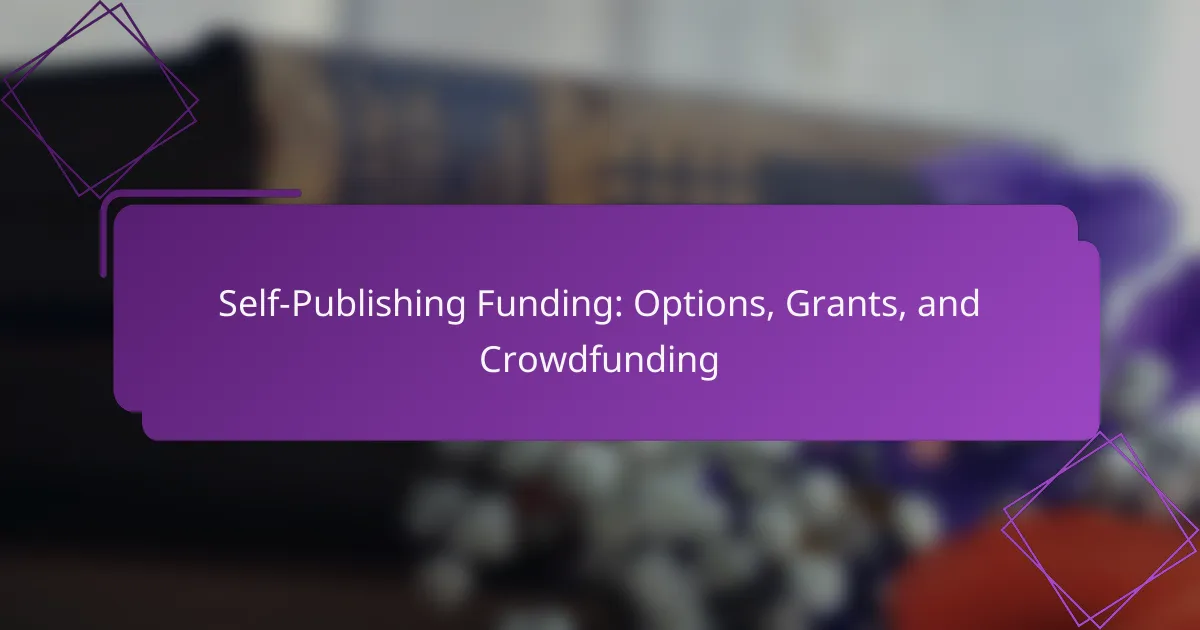Self-publishing multiple titles requires a strategic approach to financial planning, encompassing budgeting, pricing, and marketing. By carefully managing production and distribution costs, authors can maximize their profitability while effectively reaching their target audience. Implementing smart pricing strategies and utilizing comprehensive marketing techniques can further enhance revenue potential across an entire catalog of works.
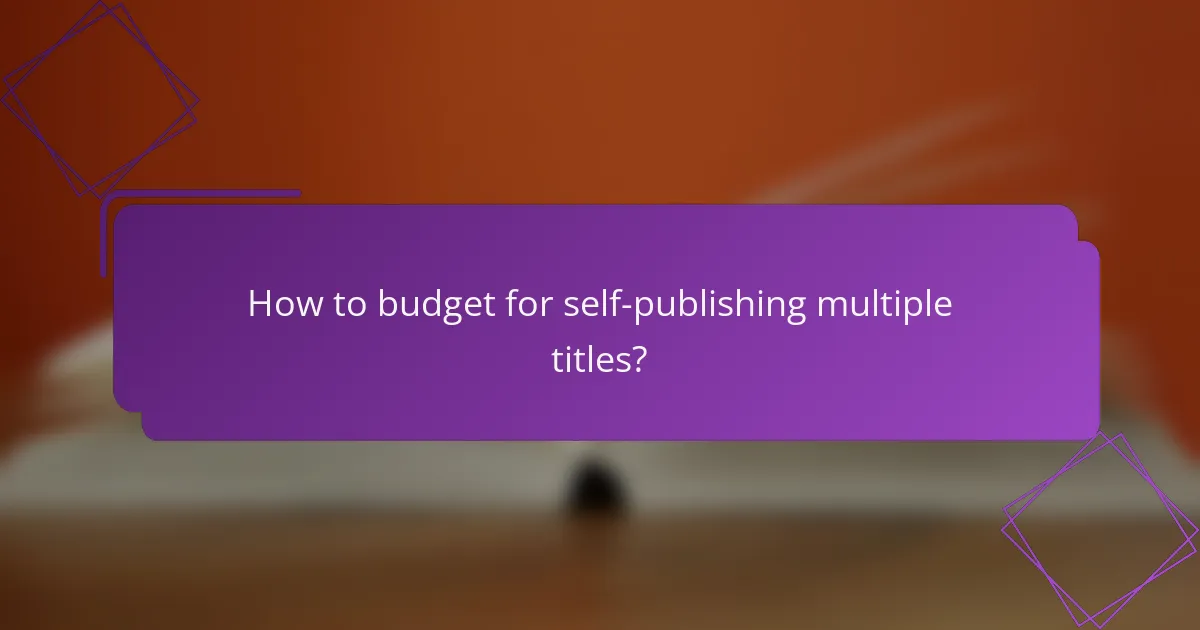
How to budget for self-publishing multiple titles?
Budgeting for self-publishing multiple titles involves careful planning of production, marketing, and distribution costs. A well-structured budget helps ensure that you allocate resources effectively across all your projects, maximizing your potential for profit.
Estimate production costs
Production costs include expenses for editing, cover design, formatting, and printing. For a single title, these costs can range from a few hundred to several thousand dollars, depending on the quality and services you choose. When budgeting for multiple titles, consider bulk discounts or package deals from service providers.
It’s wise to create a detailed list of all production elements required for each title, allowing you to compare costs and identify areas where you can save. For instance, hiring a freelance editor may be more cost-effective than using a publishing house.
Allocate marketing expenses
Marketing expenses are crucial for the success of your self-published titles. Allocate funds for online advertising, social media promotions, and book launch events. A typical budget might range from 10% to 30% of your expected revenue per title.
Consider utilizing free marketing channels, such as social media and author websites, to complement your paid efforts. Tracking the effectiveness of your marketing strategies will help you adjust your budget for future titles.
Consider distribution fees
Distribution fees can significantly impact your overall budget, especially if you plan to use multiple platforms. Many online retailers charge a percentage of sales, typically ranging from 30% to 60%. It’s essential to factor these fees into your pricing strategy to maintain profitability.
Research various distribution options, including print-on-demand services and eBook platforms, to find the best fit for your titles. Each option may have different fee structures, so understanding these will help you budget more accurately.
Factor in royalties and taxes
Royalties and taxes are critical components of your self-publishing budget. Depending on the platform, royalties can vary widely, often between 35% and 70% of the sale price. Be sure to account for these percentages when calculating potential income.
Additionally, consider local tax regulations that may apply to your earnings. Keeping track of your income and expenses will simplify tax filing and help you avoid surprises at tax time.
Use budgeting tools like QuickBooks
Utilizing budgeting tools like QuickBooks can streamline your financial planning for self-publishing. These tools help you track expenses, manage invoices, and generate financial reports, making it easier to stay on top of your budget.
Explore other budgeting software options as well, such as Mint or YNAB, to find one that suits your needs. Regularly updating your budget will provide insights into your financial health and guide your decision-making for future titles.
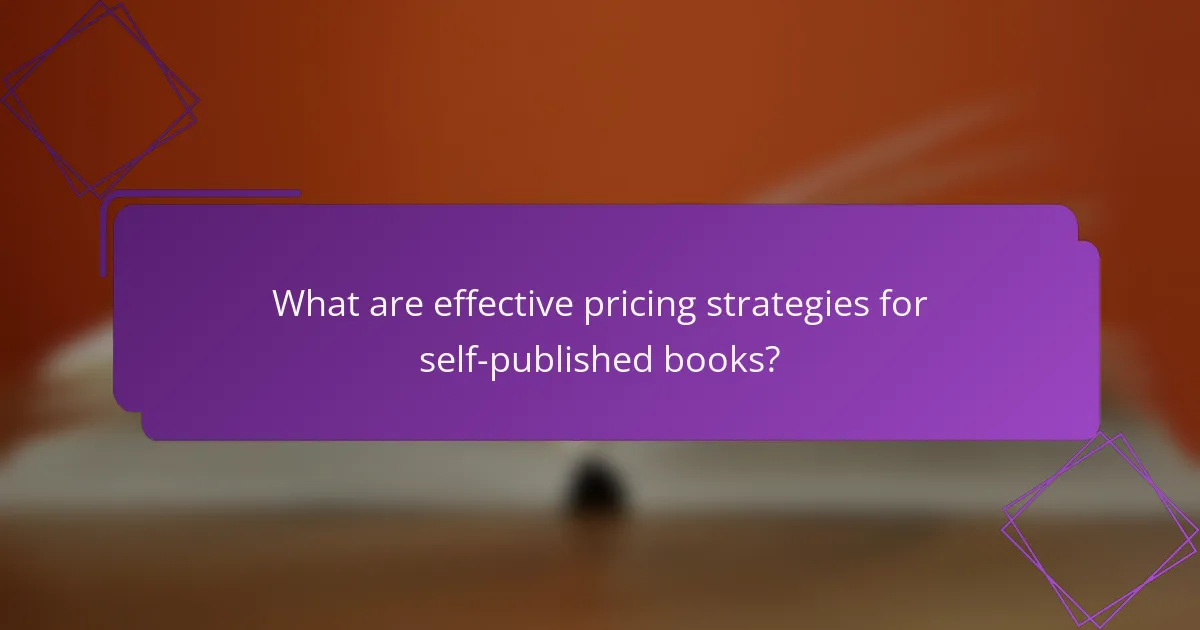
What are effective pricing strategies for self-published books?
Effective pricing strategies for self-published books involve understanding market dynamics, perceived value, and sales goals. By employing various pricing techniques, authors can optimize their revenue while appealing to their target audience.
Competitive pricing analysis
Competitive pricing analysis involves researching similar titles in your genre to determine a suitable price point. Look at bestsellers and average-priced books to gauge what readers are willing to pay. Aim to set your price within a range that reflects the quality and length of your work, typically between $2.99 and $9.99 for eBooks.
Consider factors such as author reputation, book format, and reader demographics. Tools like Amazon’s Kindle Direct Publishing (KDP) can help analyze competitors’ pricing strategies effectively.
Value-based pricing approach
The value-based pricing approach focuses on the perceived value of your book to the reader rather than just production costs. Assess what unique benefits your book offers, such as exclusive insights, compelling storytelling, or expert knowledge. This can justify a higher price point if readers see significant value.
Engage with your audience through surveys or social media to understand their willingness to pay. Adjust your pricing based on feedback and the perceived value of your content, which may range from $4.99 to $14.99 for specialized topics.
Dynamic pricing models
Dynamic pricing models allow authors to adjust their book prices based on market demand, sales performance, and promotional strategies. For instance, you might lower the price during a launch period to encourage initial sales or raise it after achieving a certain number of reviews.
Utilize promotional tactics such as limited-time discounts or price drops during seasonal sales. Monitor your sales data regularly to identify trends and adjust your pricing accordingly, ensuring you remain competitive while maximizing revenue.
Bundle pricing for multiple titles
Bundle pricing for multiple titles can attract more readers and increase overall sales. By offering a collection of books at a discounted rate compared to purchasing each title separately, you create added value for customers. This strategy works well for series or related topics.
Consider pricing bundles at around 20-30% less than the total cost of individual titles. Promote the bundle through your website and social media to highlight the savings and encourage bulk purchases, which can enhance your visibility and reader loyalty.
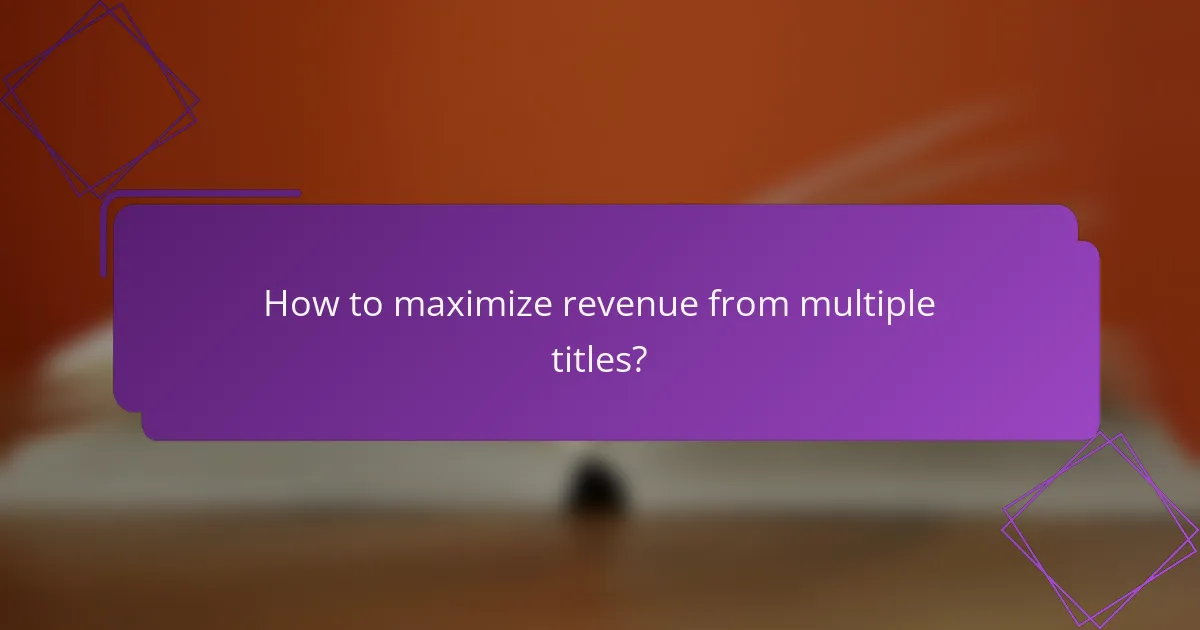
How to maximize revenue from multiple titles?
To maximize revenue from multiple titles, authors should focus on strategic marketing techniques that promote their entire catalog. By implementing cross-promotion, leveraging email marketing, utilizing social media advertising, and engaging in affiliate marketing, authors can significantly boost their sales and reach a wider audience.
Implement cross-promotion techniques
Cross-promotion involves marketing multiple titles simultaneously to encourage readers to explore more of your work. For example, you can bundle related titles at a discounted price or include links to other books in the back matter of each title. This approach not only increases visibility but can also enhance reader loyalty.
Consider creating a series or themed collections that naturally lead readers from one title to another. Offering exclusive content or bonuses for readers who purchase multiple titles can also incentivize sales.
Leverage email marketing campaigns
Email marketing is a powerful tool for promoting multiple titles to your existing audience. Building an email list allows you to share updates, new releases, and special promotions directly with interested readers. Aim to send regular newsletters that highlight your entire catalog, upcoming projects, or exclusive offers.
Segment your email list based on reader preferences to tailor your messages effectively. For instance, if a reader has purchased a specific genre, send them information about related titles in that genre to increase engagement and sales.
Utilize social media advertising
Social media advertising can help you reach a broader audience and promote multiple titles effectively. Platforms like Facebook, Instagram, and Twitter allow for targeted ads that can be customized based on user interests and demographics. Create visually appealing ads that showcase your titles and direct users to your sales page.
Consider running campaigns that highlight a new release while promoting older titles as well. Using engaging visuals and compelling copy can capture attention and encourage clicks, leading to increased sales across your catalog.
Engage in affiliate marketing
Affiliate marketing allows you to partner with bloggers, influencers, or websites that can promote your titles in exchange for a commission on sales. This strategy can expand your reach significantly without upfront costs. Identify affiliates whose audience aligns with your target market for the best results.
Provide affiliates with promotional materials, such as banners or sample chapters, to make it easy for them to share your work. Regularly track the performance of your affiliates to optimize your partnerships and ensure you are maximizing revenue from this channel.
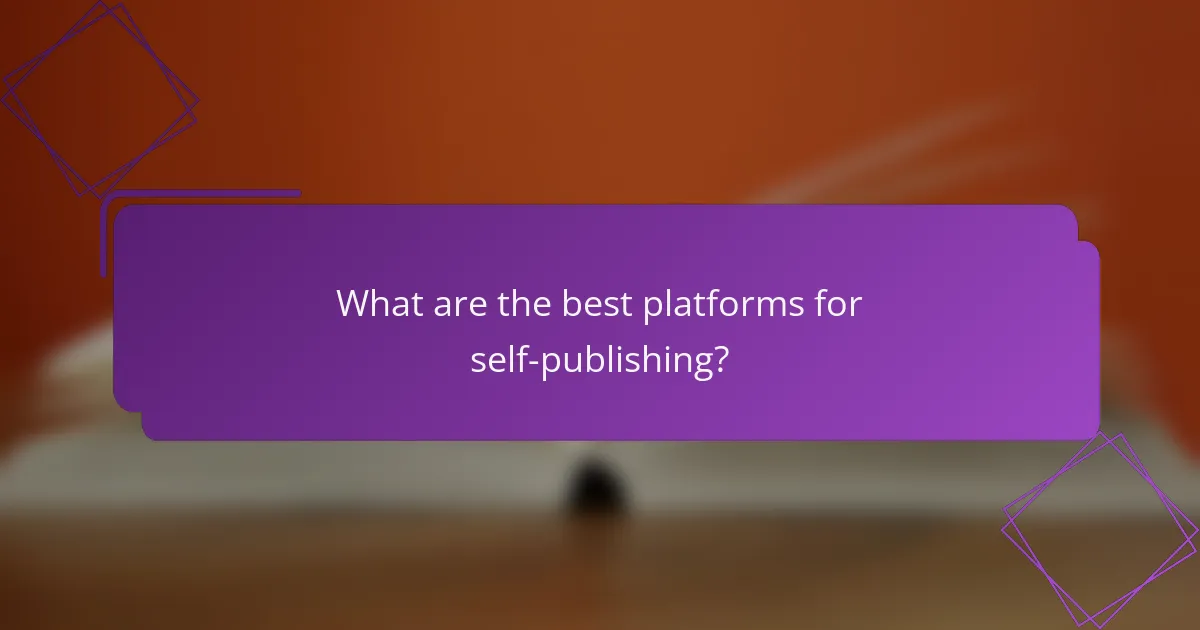
What are the best platforms for self-publishing?
The best platforms for self-publishing include Amazon Kindle Direct Publishing, IngramSpark, and Smashwords. Each platform offers unique features and distribution options that cater to different author needs and goals.
Amazon Kindle Direct Publishing
Amazon Kindle Direct Publishing (KDP) is a popular choice for self-publishing authors due to its vast reach and user-friendly interface. Authors can publish eBooks and paperbacks for free, receiving up to 70% royalties on eBook sales depending on pricing and distribution choices.
To get started, authors simply create an account, upload their manuscript, and set their pricing. KDP also offers promotional tools like Kindle Unlimited and Countdown Deals, which can help boost visibility and sales.
IngramSpark for wider distribution
IngramSpark is ideal for authors seeking broader distribution beyond Amazon. This platform allows authors to publish both print and eBooks, making them available to bookstores, libraries, and online retailers globally.
While there are setup fees involved, IngramSpark provides extensive distribution options and access to a larger network. Authors should consider the costs and potential return on investment when choosing this platform, especially if aiming for physical book sales.
Smashwords for eBook publishing
Smashwords specializes in eBook publishing and distribution, offering authors a straightforward way to reach multiple retailers, including Apple Books and Barnes & Noble. The platform is free to use, with authors earning royalties of around 60% to 80% based on the retailer.
Authors can upload their manuscripts in various formats and utilize Smashwords’ extensive distribution network. It’s essential to format the eBook correctly to meet Smashwords’ guidelines to ensure a smooth publishing process.

What are the key metrics to track in self-publishing?
Key metrics in self-publishing include sales figures, reader engagement, and marketing effectiveness. Tracking these metrics helps authors understand their performance and make informed decisions for future titles.
Sales figures per title
Sales figures are crucial for evaluating the financial success of each title. This includes total sales, revenue generated, and average sales per month. Authors should aim to track these figures regularly to identify trends and adjust marketing strategies accordingly.
Consider setting benchmarks based on genre or similar titles. For instance, if a comparable book sells around 500 copies in its first year, use that as a target. Monitoring sales over time can reveal seasonal patterns or the impact of promotional efforts.
Reader engagement statistics
Reader engagement statistics provide insight into how well your audience connects with your content. Metrics such as average reading time, completion rates, and reviews can indicate whether readers are enjoying your work. High engagement often correlates with better sales and word-of-mouth marketing.
Utilize platforms that offer analytics, such as Amazon KDP or social media insights, to gather this data. For example, if readers frequently leave positive reviews or share your book, it suggests strong engagement. Aim for a completion rate of at least 70% to ensure your content resonates with your audience.

